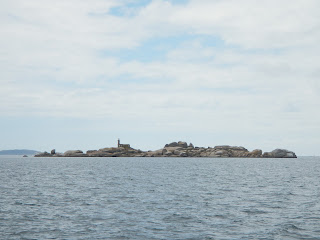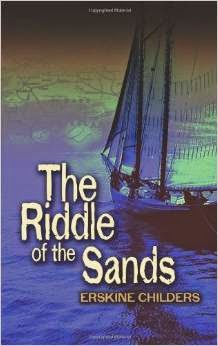Visiting the Parque Nacional Illas Atlánticas
 |
| Illas de Cies |
We left the Finisterre region and sailed back southward toward the Rias Baixas. We had not yet visited the barrier islands but had secured our initial permission document before heading out of Ireland.
In the 1980s, Spain acquired several archipelagos of islands off the Atlantic coast and established a National Park to ‘preserve’ these islands. The Cortegada Archipelago is well inside the Ria de Arousa. The Salvora Archipelago is in the mouth of the Ria de Arousa. The Ons Archipelago protects the Ria de Pontevedra, and the Cíes Archipelago sits across mouth of the Ria de Vigo. These islands form natural barriers against the forces of the Atlantic, protecting the sealife and shores of the Rias Baixas. The archipelagos have waters so turquoise and sands so white that they evoke Caribbean beaches...until you put your foot in the water. Let's just say it's refeshing.
Navigation Permission
To visit the Salvora, Ons and Cies islands, one can go by ferry or get a permit to anchor a boat in their waters. The permit is acquired as a two-step process. This is quicker and easier than the RCCPF pilot suggests. Enter www.iatlanticas.es/formulario/formulario_ingles.pdf to access the form. The application form must be printed and filled out manually (not possible online). Scan completed form together with passport, vessel registration, and Certificate of Competence or similar document. Email to fondeos.iatlanticas@xunta.es with short explanatory letter preferably in Spanish. If you are unsure, phone the Park HQ (Xunta) at +34 886 21 80 90 to ensure that the email had been received and was adequate.Apply well in advance and receive a permit via return email, often within hours, that you must print out and carry aboard to show to an island warden if required. The permit is good for two years. One then goes online and requests permission to visit and anchor in specific islands on specific dates. Permission is given or denied on the spot. Some days are booked out when holiday makers visit en masse. (Hint: the identification number required online is your passport number.) In Salvora, the ranger comes out to check passes. We were not aware of anyone checking vessels in Ons and Cies.
Application for Anchoring Permission can be done with assistance of marina staff in the appropriate Ría. As the islands have Wifi which reaches out to the anchorages, it is possible to request permission on arrival if conditions are suitable. If you receive permission and decide not to go on a certain day, please contact them to cancel your request.
Illas Cies in the Ria de Vigo
The Illas Cíes get more than 1 million visitors annually via one ferry line alone, so do not expect to be alone. The main islands, Monteagudo (North) and do Faro (lighthouse) or do Medio (Middle) are connected by a causeway. There are well-maintained walking trails all around the islands. The farther away one gets from the ferry terminal, the less humanity one encounters. There are multiple lighthouses, high dunes, bird sanctuaries, curious rock formations, and idyllic beaches more akin to the Caribbean than Atlantic Spain.
Inland are massive government run campgrounds where hundreds of tourists can spend the night. The campgrounds even have a convenience store and restaurants. The main anchorage runs along the length of the main beach, rated as the Best Beach in the World by the Guardian. Many of the visiting yachts leave by 8 pm and the anchorages become refuges once again. We chose to anchor off the southern end of the middle island, which gave us shelter from the northerlies and access to shore via a tiny less populated beach.
A friend of ours recalled how he and his siblings would spend the summers in his grandfather's hunting lodge there long ago. He described it as idyllic then, with little boats on the lagoon and fishing for octopus. Today, he takes his family on occasion in the summer but he says visitor's do not respect private property and there are no enough facilities for the volume of visitors permitted. Whereas the government acquired the islands to protect them, it seems the reverse is happening.
The smaller of the two main islands in the Illas de Ons is off limits to visitors as a bird sanctuary. Illa de Ons gets fewer visitors than the Cíes, and few go beyond the village at the ferry dock. There is a fine arid walk to a lighthouse and a blow hole on the western end of the island. In general, Ons seemed to have much less vegetation than Cies.
There is a small population of people still living year round on these islands. That's interesting from the perspective of imagining what it's like to spend winters there with just a few other souls for company.
The anchorage off the beach to the north is quite comfortable; moorings close to the ferry dock in very deep rocky water are spaced very close together so getting an outside mooring is recommended. Most visitors are day trippers. The restaurant overlooking the water is the preferred place to eat, but on the weekend when the ferries arrive, do not expect to be served quickly.
Perhaps our favourite of the islands was Salvora. The anchorage is attractive with a castle and statue of a mermaid carved on a rock. Like the other islands it is exposed to the east. There’s an inner anchorage for small boats with a pontoon used by the small fast ferry where it is possible to tie off a dinghy.
In our opinion Salvora is the most interesting of the islands. Few tourists, lovely walking trails, interesting rock formations, wild horses, a Castillo museum, and an abandoned village. Lovely beach, too, at least at low tide. Oh, and the sword in the stone. Really.
We walked first to the lighthouse to get away from some noisy tourists. The lighthouse was interesting with the story about how a group of women staying at the lighthouse one Christmas saw a ship go aground. They rowed out to the ship and saved many people.
Then we walked to the deserted village. People lived here in a community that preserved fish until the 1970s. It was very interesting. On the way back, wild horses joined us on our walk. It was quite lovely. They are tame and friendly. Alex tried to pull the sword from the stone but it wouldn't budge. Oh well, no kingdom for us that day.
Finally, we visited the museum which is just getting started. They have some nice early implements, including early anchors and traditional craft.
On the way back to Aleria, we stopped to photograph the mermaid on the rock. Lovely, but we couldn't spook the bird off her head. Oh well.
Although we anchored at Illa de Tambo, we did not go ashore.
To apply for a permit or learn more about the islands, visit here and here.
Inland are massive government run campgrounds where hundreds of tourists can spend the night. The campgrounds even have a convenience store and restaurants. The main anchorage runs along the length of the main beach, rated as the Best Beach in the World by the Guardian. Many of the visiting yachts leave by 8 pm and the anchorages become refuges once again. We chose to anchor off the southern end of the middle island, which gave us shelter from the northerlies and access to shore via a tiny less populated beach.
A friend of ours recalled how he and his siblings would spend the summers in his grandfather's hunting lodge there long ago. He described it as idyllic then, with little boats on the lagoon and fishing for octopus. Today, he takes his family on occasion in the summer but he says visitor's do not respect private property and there are no enough facilities for the volume of visitors permitted. Whereas the government acquired the islands to protect them, it seems the reverse is happening.
Illas de Ons in the Ria Pontevedra
The smaller of the two main islands in the Illas de Ons is off limits to visitors as a bird sanctuary. Illa de Ons gets fewer visitors than the Cíes, and few go beyond the village at the ferry dock. There is a fine arid walk to a lighthouse and a blow hole on the western end of the island. In general, Ons seemed to have much less vegetation than Cies.
There is a small population of people still living year round on these islands. That's interesting from the perspective of imagining what it's like to spend winters there with just a few other souls for company.
The anchorage off the beach to the north is quite comfortable; moorings close to the ferry dock in very deep rocky water are spaced very close together so getting an outside mooring is recommended. Most visitors are day trippers. The restaurant overlooking the water is the preferred place to eat, but on the weekend when the ferries arrive, do not expect to be served quickly.
Illas Salvora in the Ria de Arousa
Perhaps our favourite of the islands was Salvora. The anchorage is attractive with a castle and statue of a mermaid carved on a rock. Like the other islands it is exposed to the east. There’s an inner anchorage for small boats with a pontoon used by the small fast ferry where it is possible to tie off a dinghy.
In our opinion Salvora is the most interesting of the islands. Few tourists, lovely walking trails, interesting rock formations, wild horses, a Castillo museum, and an abandoned village. Lovely beach, too, at least at low tide. Oh, and the sword in the stone. Really.
We walked first to the lighthouse to get away from some noisy tourists. The lighthouse was interesting with the story about how a group of women staying at the lighthouse one Christmas saw a ship go aground. They rowed out to the ship and saved many people.
Then we walked to the deserted village. People lived here in a community that preserved fish until the 1970s. It was very interesting. On the way back, wild horses joined us on our walk. It was quite lovely. They are tame and friendly. Alex tried to pull the sword from the stone but it wouldn't budge. Oh well, no kingdom for us that day.
Finally, we visited the museum which is just getting started. They have some nice early implements, including early anchors and traditional craft.
On the way back to Aleria, we stopped to photograph the mermaid on the rock. Lovely, but we couldn't spook the bird off her head. Oh well.
Cortegada and Tambo
We did not visit the third grouping of islands, Cortegada, up in the Ria de Arousa near Villagarcia. The waters around it are shallow and we have a deep draft vessel.Although we anchored at Illa de Tambo, we did not go ashore.
 |
| Illa de Tambo anchorage |
 |
| Lighthouse on Tambo |















































Comments
Post a Comment